 ... more info
... more info
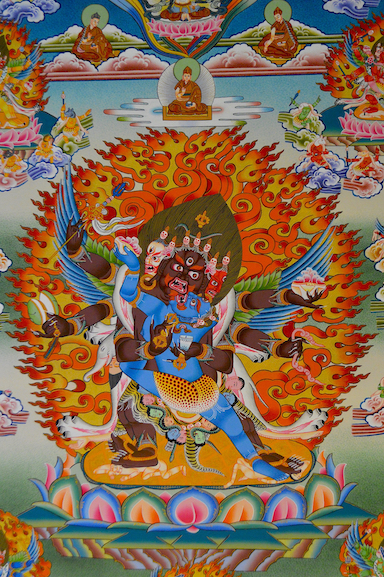
Thrangu Rinpoche has written a 200 page book on Journey of the Mind:Preparing for the Bardo in Life, Dreams, Meditation, while Dying, and Rebirth (available on this website under Thrangu Rinpoche's works ). The Bardo is the interval between between death and rebirth in a new body. For a...
 ... more info
... more info
Max: 1
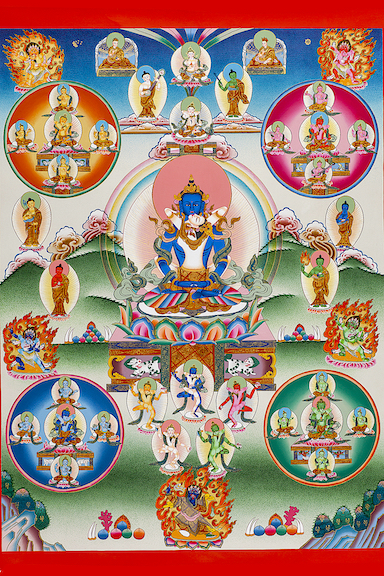
Thrangu Rinpoche has written a 200 page book on Journey of the Mind:Preparing for the Bardo in Life, Dreams, Meditation, while Dying, and Rebirth (available on this website under Thrangu Rinpoche's works ). The Bardo is the interval between between death and rebirth in a new body. For a...
 ... more info
... more info
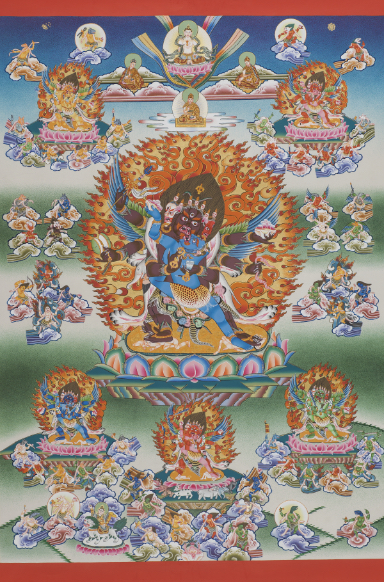
Thrangu Rinpoche has written a 200 page book on Journey of the Mind:Preparing for the Bardo in Life, Dreams, Meditation, while Dying, and Rebirth (available on this website under Thrangu Rinpoche's works ). The Bardo is the interval between between death and rebirth in a new body. For a...
 ... more info
... more info
Max: 1
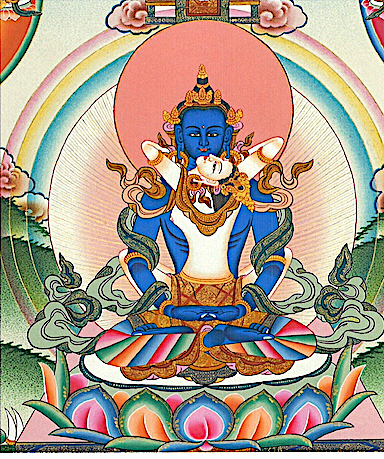
Thrangu Rinpoche has written a 200 page book on Journey of the MInd:Preparing for the Bardo in Life, Dreams, Meditation, while Dying, and Rebirth (available on this website under Thrangu Rinpoche's works ). The Bardo is the interval between between death and rebirth in a new body. For a...
 ... more info
... more info
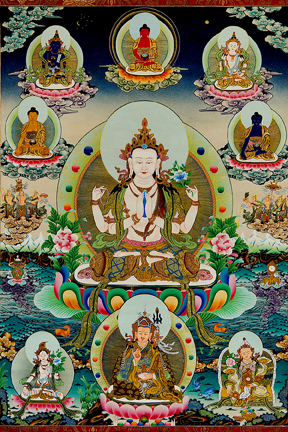
Chenrezig also known Avalokiteshvara is the most popular deity in Tibet. Chenrezig is the deity representing complete, universal compassion and his mantra is the famous: OM MANI PEDME HUNG (Tibetan pronunciation). Chenrezig is the patron saint of Tibet. The Chenrezig practice, for example, is done...
 ... more info
... more info
Max: 1
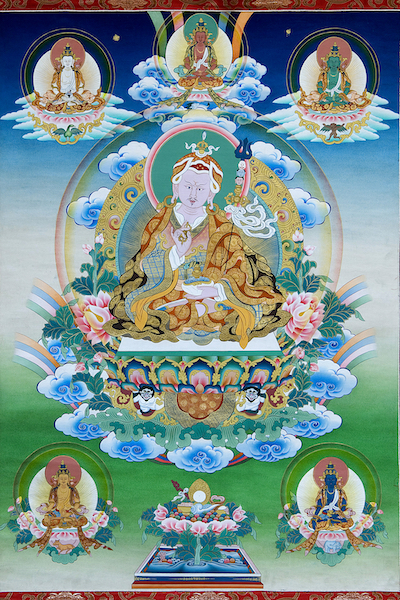
Guru Rinpoche (Skt. Padmasambhava ) is considered the second Buddha in Tibet introduced Buddhist practice to Tibet. Guru Rinpoche had to subdue many of the local deities who were resisting conversion to Buddhism and there for is depicted as a magician with a staff with the three heads representing...
 ... more info
... more info
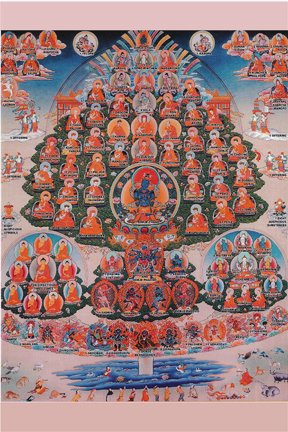
The Kagyu lineage tree not only has the lineage masters down to the 16th Karmapa, but it also contains the important sacred sangha and yidams and protectors of the lineage and other important realized individuals such as Niguma, Khentse Wangpo, Machtig Ladron, Pagmo Drukpa and Dolpopa. This lineage...
 ... more info
... more info
Max: 1

His Holiness the Seventeenth Karmapa ( Orgyen Trinley Dorje ) is head of the Karma Kagyu Lineage.
 ... more info
... more info
Max: 1
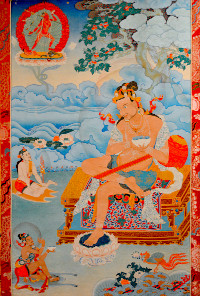
Naropa lived in India and taught at Nalanda Monastic University in the Eleventh century was approached one day while he was studying by a dakini who asked him if he understood what he was reading and when Naropa said, "yes" she became very upset and told him he should go see "her...
 ... more info
... more info
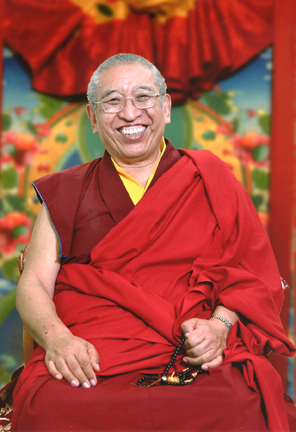
This is the Shrine photo of Thrangu Rinpoche taken in Crestone several years ago. This photo is of high quality (300dpi) and copyright free. You may download either the smaller 4 by 6 inch or the larger 8 inch by 10 inch photo each for $ 0.50. You can also order a print of this photo in the Dharma...
 ... more info
... more info
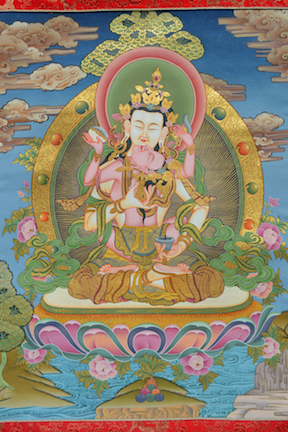
Vajrasattva is white signifying purity and sits on a moon disk on top of a lotus throne. In his left hand is an upside down bell resting on his left thigh representing the wisdom aspect and in his right hand is a vajra placed at his heart level representing the skillful means aspect. Vajrasattva...
 ... more info
... more info
Max: 1
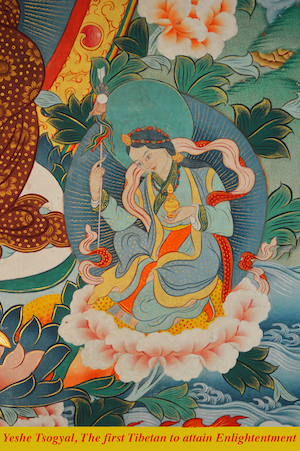
Yeshe Tsogyal was a woman practitioner who met Padmasambhava (Guru Rinpoche) when he came to Tibet to establish Buddhism in Tibet. She became one of his closest desciples and did many activities with him such as hiding teachings (termas) to be recovered years later when Tibetans would be able...
$0.50... more info
Max: 1
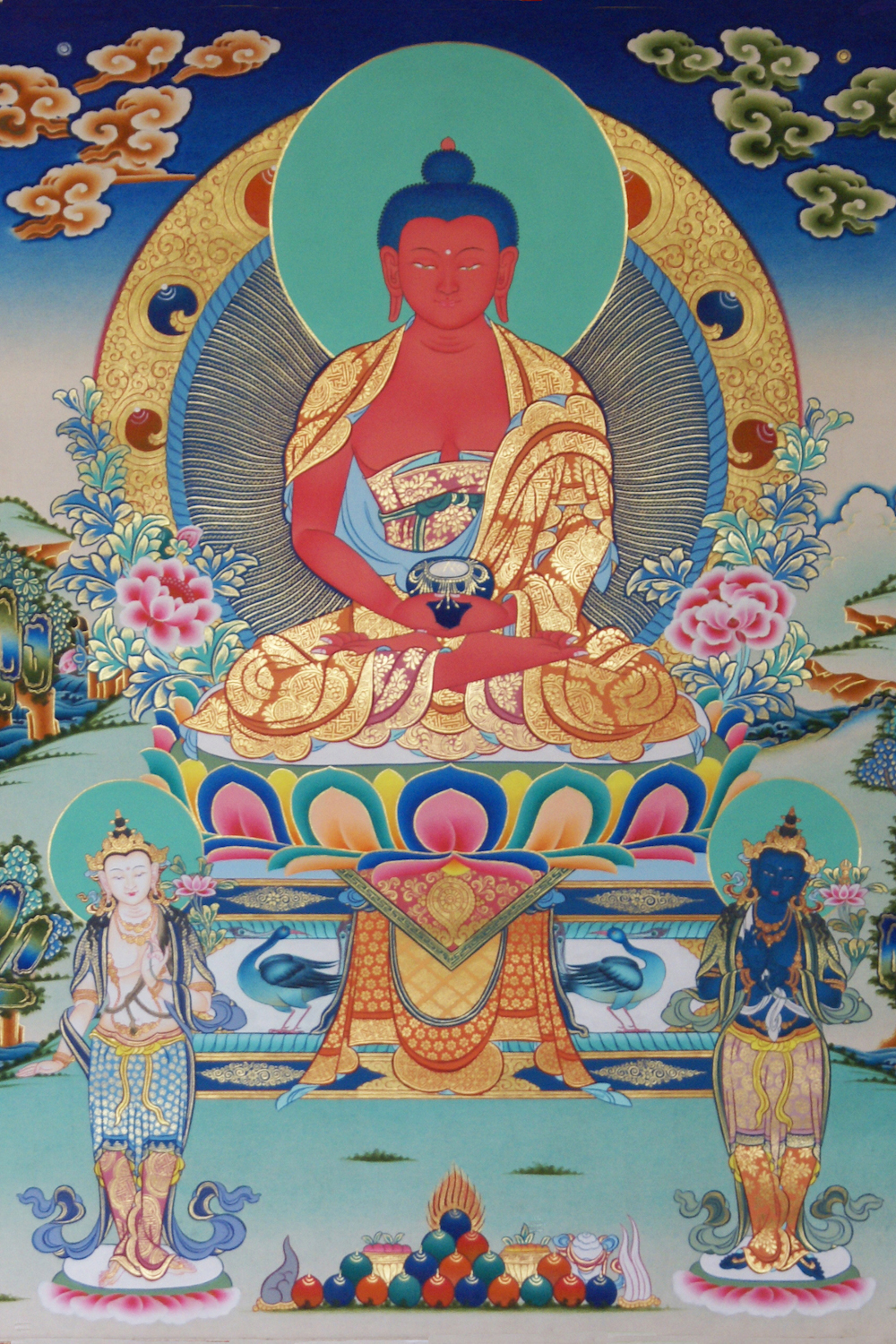
Amitabha is one of the five Wisdom Buddhas and is located in madalas in the west and is red in color. He resides in Sukhavati (Tib. Dewachen) and sits in the full-lotus with his hands in the meditation position and sometimes has his left hand holding a begging bowl. He belongs to the lotus (padma)...
$0.50... more info
Max: 1
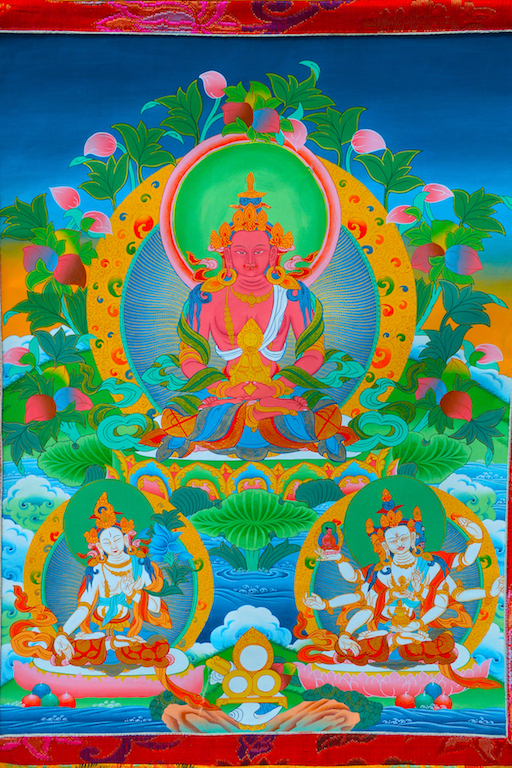
This is a very striking painting which is very detailed. In the middle we have Amitayus called “The Buddha of Infinite Life” red in color, sitting in vajra posture and wearing the sambhogakaya form with silk garments, elaborate crown, necklace, earrings, and bracelets. His hands are in...
$0.50... more info
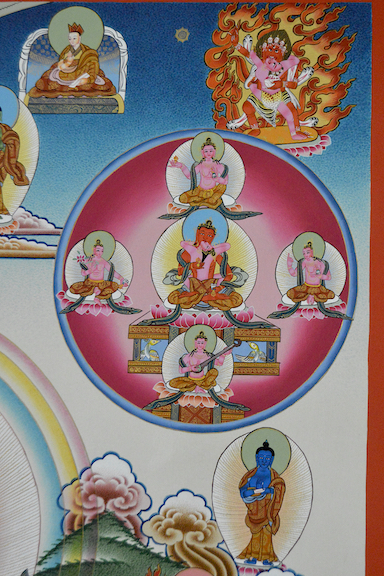
Thrangu Rinpoche has written a 200 page book on Journey of the MInd:Preparing for the Bardo in Life, Dreams, Meditation, while Dying, and Rebirth (available on this website under Thrangu Rinpoche's works ). The Bardo is the interval between between death and rebirth in a new body. For a...
$0.50... more info
Max: 1
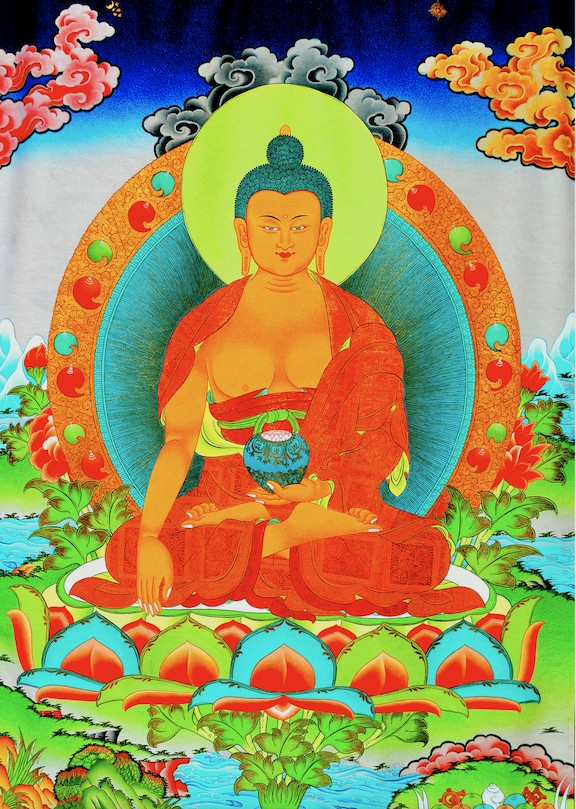
This is a picture of the Buddha touching the earth. The Buddha while he was meditating and was asked if he was really enlightened, he touched the earth and said "let the Earth be my witness. He is depicted on a 16 petaled lotus in full lotus posture touching the earth with his left hand and...
$0.50... more info
Max: 1
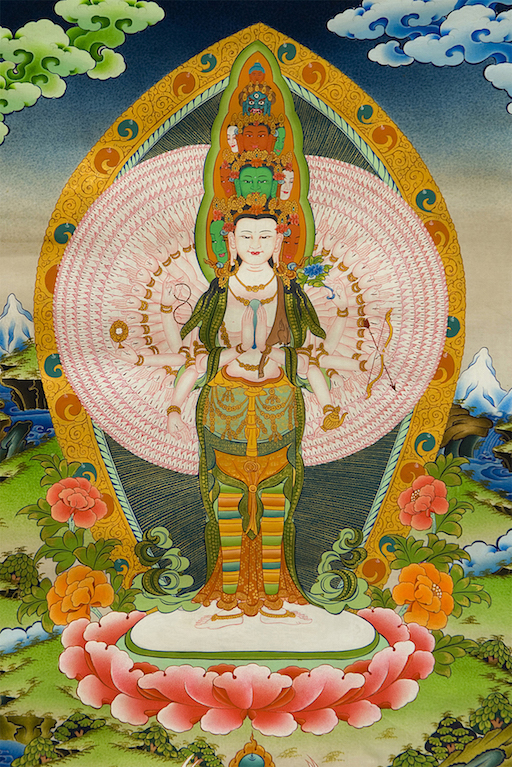
Chenrezig also known Avalokiteshvara is the most popular deity in Tibet. Chenrezig is the deity representing complete, universal compassion and his mantra is the famous: OM MANI PEDME HUNG (Tibetan pronunciation). Chenrezig is the patron saint of Tibet. The Chenrezig practice, for example, is done...
$0.50... more info
Max: 1
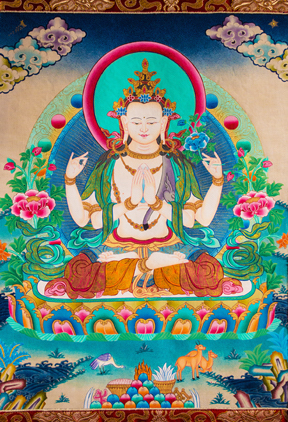
Chenrezig also known by his Sanskrit name Avalokiteshvara is the most popular deity in Tibet. He is the deity of representing compassion and his mantra is the famous: OM MANI PEDME HUNG. The Chenrezig practice is done every night by the children attending Thrangu Rinpoche's grade school in...
$0.50... more info
Max: 1
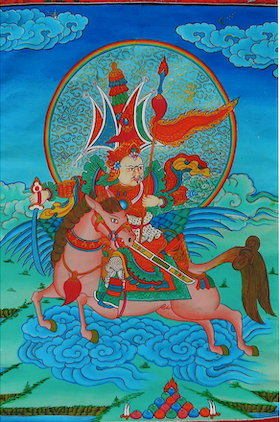
One of the oldest epics in Tibetan literature is the story of Gesar of Ling which was being orally recited long before Tibet became a Buddhist country in the Seventh Century CE. This legend is very long and used to be recited from memory by Tibetan story tellers much like the Odessy was...
$0.50... more info
Max: 1
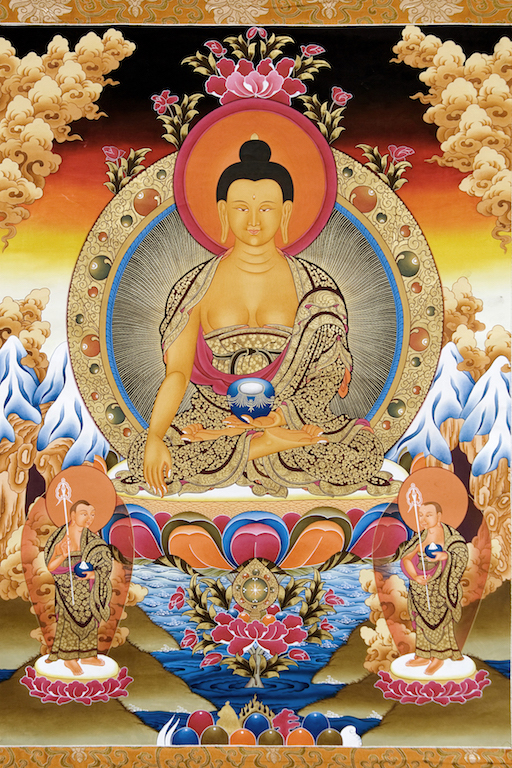
Before reaching enlightenment, the Buddha meditated under the Bodhi tree for six weeks. When the Buddha reached enlightenment and was asked how he knew he was enlightened, he touched the earth and said, "Let the earth be my witness." The Buddha is pictured as gold, holding his begging...
$0.50... more info
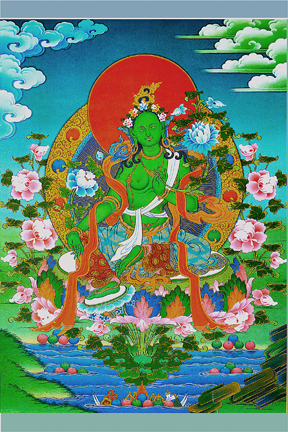
Tara is widely revered in both India and Tibet. Originally, Tara was in India the patron saint of sea goers who prayed to her to protect them from drowning. Gradually, she became a protectoress, like a mother, who protected one from things such as financial ruin, being incarcerated, contracting a...
$0.50... more info
Max: 1
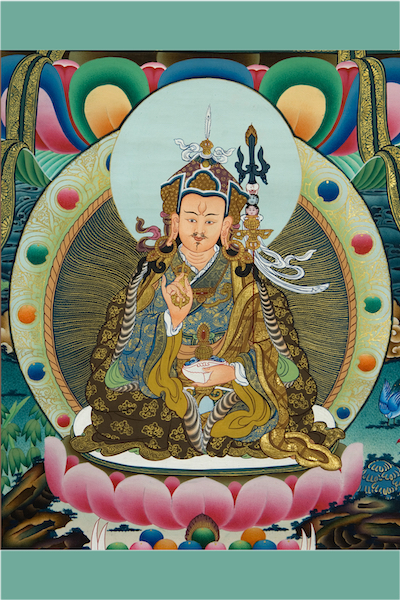
Guru Rinpoche (Padmasambhava) was considered a second Buddha in Tibet because he brought Buddhism from India to Tibet and established its first lineage--the Nyingma lineage. In this depiction Guru Rinpoche is in the mudra of the Konchog Chidu Practice on a lotus throne with his staff which...
$0.50... more info
Max: 1
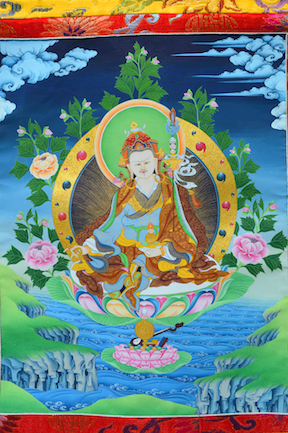
Guru Rinpoche was considered a second Buddha in Tibet because he was invited to Tibet buy King Trisong Detsen and brought Buddhism Tibet. He established Buddhism in Tibet in the 7th century CE, helped translate the Indian Buddhist works into Tibetan, built the first Budhist monastery in Tibet...
$0.50... more info
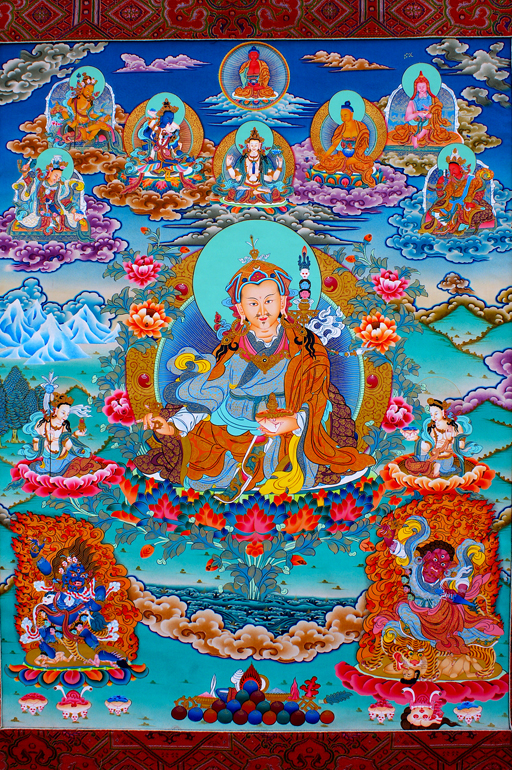
Guru Rinpoche is considered the second Buddha by the Tibetans. In the Seventh Century CE he brought Buddhism to the land of Tibet, founded the Nyingma lineage and is said to have conquered many the local deities that opposed him and turned them into Dharma Protectors. He was a magician in addition...
$0.50 Buy Now
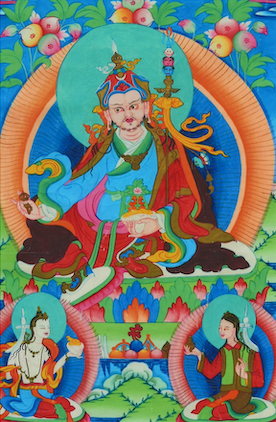
Guru Rinpoche (Padmasambhava) was considered a second Buddha in Tibet because he brought Buddhism from India to Tibet and established its first lineage--the Nyingma lineage. In this picture he is depicted in his usual costume with his staff with three heads holding a Vajra in this right hand in...
$0.50... more info
Max: 1
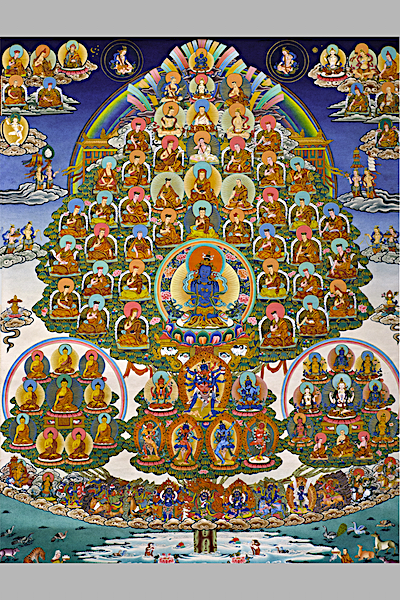
The Kagyu lineage tree not only has the lineage masters down to the 16th Karmapa, but it also contains the important sacred sangha and yidams and protectors of the lineage and other important realized individuals such as Niguma, Khentse Wangpo, Machtig Ladron, Pagmo Drukpa and Dolpopa. This lineage...
$0.50... more info
Max: 1
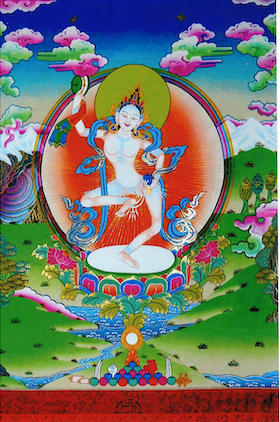
Machig Labdrön is one of Tibet's most famous practitioners who introduced the practice of Chod (cutting off) practice to cut one's attachement a one's body and self. It is said that this practice was one of very few Buddhist practices that orginated in Tibet and actually then went...
$0.50... more info
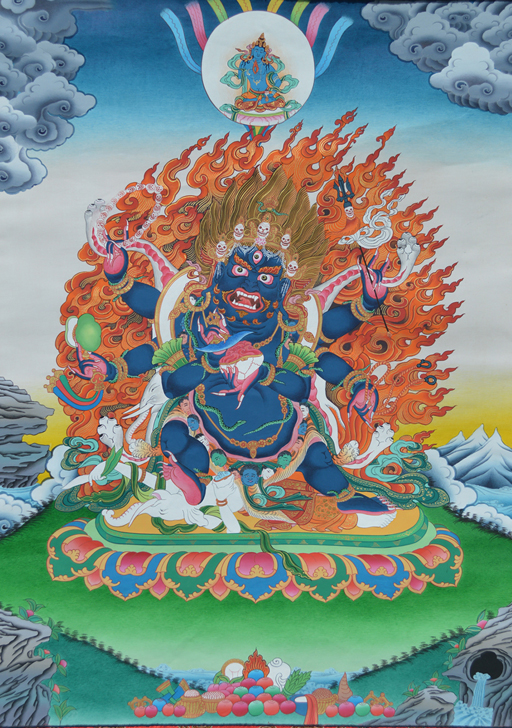
The deities in Tibetan Buddhism are divided into peaceful and wrathful deities. The wrathful ones are often Dharma protectors and one of the most famous dharma protector is Mahakala. Mahakala comes in many forms with the two-armed, four-armed and six-armed Mahakala being most common. Mahakala is...
$0.50... more info
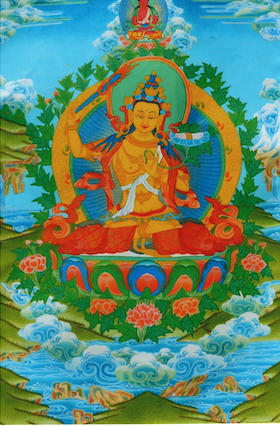
Manjushri is the embodiment of the wisdom of all the buddhas. He is golden in color and holds a flaming sword with a vajra as a handle in this right hand and a lotus flower holding a book of the Prajnaparamita teachings on emptiness in his left hand. His sword cuts through all ignorance so that the...
$0.50... more info

Manjushri is the embodiment of the wisdom of all the buddhas. He is golden in color and holds a flaming sword with a vajra as a handle in this right hand and a lotus flower holding a book of the Prajnaparamita teachings on emptiness in his left hand. His sword cuts through all ignorance so that the...
$0.50 Buy Now

Manjushri is the deity associated with Wisdom. In most Kagyu Monasteries this prayer is recited before doing any intellectual activity. This photo is of high quality (300dpi) and copyright free. You may download either the smaller 4 by 6 inch or the larger 8 inch by 10 inch photo each for $ 0.50.
$0.50... more info
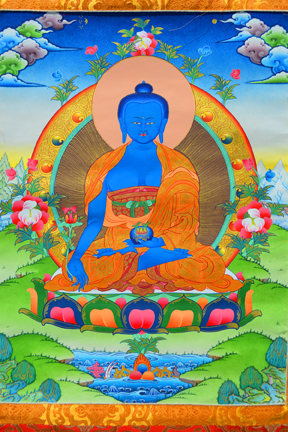
Thrangu Rinpoche says that all deities are very similar in that they devote themselves to helping sentient beings. But beings have many different propensities and karma, so the deities manifest in different forms. The Medicine Buddha looks similar to the Shakyamuni Buddha touching the ground, but...
$0.50... more info
Max: 1
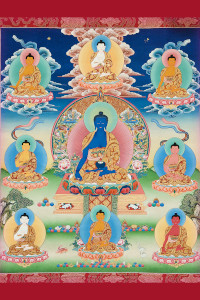
In the Medicine Buddha practice there is the main Medicine Buddha who is shown here the color of lapis and holding the arura plant in the offering gesture in his right hand and a bowl of medicine buddha in his left. He is directly under the Akshobhya Wisdom Buddha whose family he belongs to. The...
$0.50... more info

There are three major deities that help in longlife practices. These are Amitabha, Namgyalma, and White Tara. We have photos of each of these on the website. Namgyalma's official name in Sanskrit is Ushnisha Vijaya, but since this deity was adopted by Namgyal monstery she has been called...
$0.50... more info
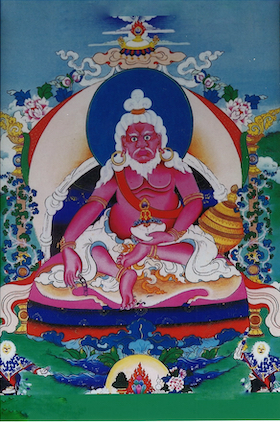
Tangtong Gyalpo is famous for not only being great practitioner who originated the Chenrezig practice, but also the first person respoonsible for Building metal bridges across the the steep ravines in Tibet thus saving the people days and safety in their travels. Many Tibetan homes have a picture...
$0.50... more info
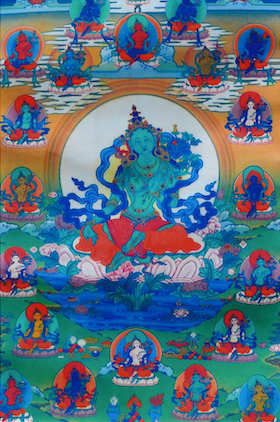
Tara is female deity which originated in India and was adopted by the Tibetans and is very popular because she is a protector. Traditonally , Tara protects one from the dangers faced in earlier times such as being drowned in a ship, being imprisioned, being bitten by.snake and so on. But Tara is...
$0.50... more info
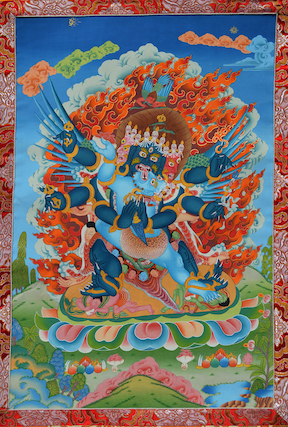
All of these photos are very high quality (300 dpi) and free of copyright restrictions. You can download the medium size (4 by 6 inches) or the large size (8 x 10 inches) or both. You can also order a print of this photo in the Dharma Photos section of this website.
$0.50... more info
Max: 1
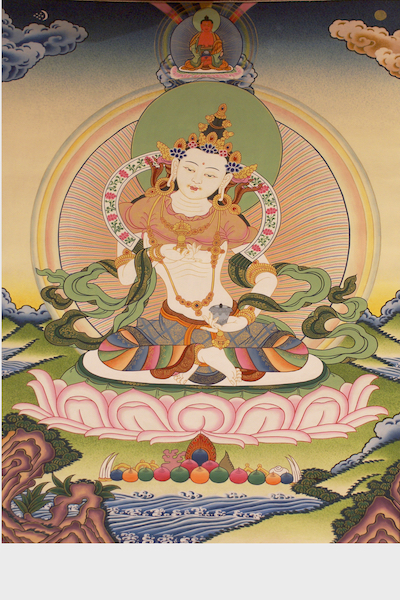
Vajrasattva is the deity representing purification. He is white signifying purity and sits on a moon disk on top of a lotus throne. In his left hand is an upside down bell resting on his left thigh and in his right hand is a vajra placed at his hear level. Above his head is Amitabha because he...
$0.50... more info
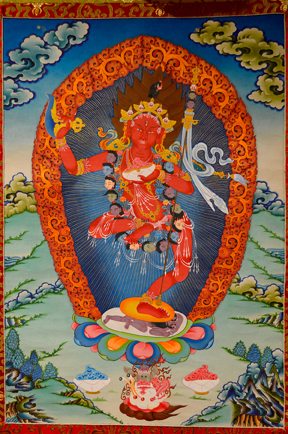
Vajrayogini is a major Deity in the Kagyu lineage who was introduced into the lineage by Naropa. Vajrayogini has since been adopted into other lineages and is often depicted in several different poses. This particular posture shows Vajrayogini red in color with flames around her showing that she is...
$0.50... more info
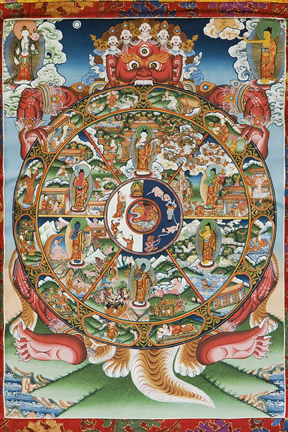
The Wheel of Life is a visual depiction of cyclic existence (samsara) as taught in the Buddhist teachings. On the outside of the wheel is Yamataka (the Lord of Death) who is consuming everything in samsara when it dies. Then in the outer circle is the 12 links of dependent origination. Next is...
$0.50... more info
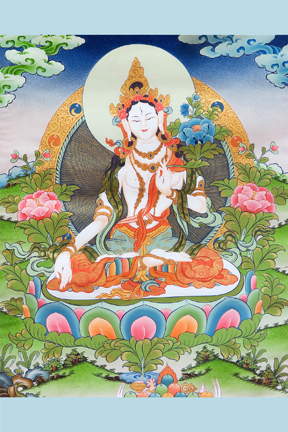
Tara is connected closely to protection. Often Tibetans will prayer to Tara to protect them from violence, unjust incarceration, dangerous animals which are much more common in India, drowning in an ocean and so on. There are actually 21 taras each with a different color, family, and type of...
$0.50... more info
Max: 1
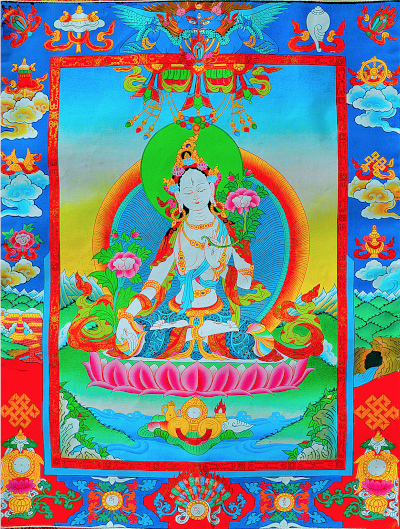
Tara is connected closely to protection. Often Tibetans will prayer to Tara to protect them from violence, unjust incarceration, dangerous animals which are much more common in India, drowning in an ocean and so on. There are actually 21 Taras each with a different color, family, and type of...
$0.50... more info
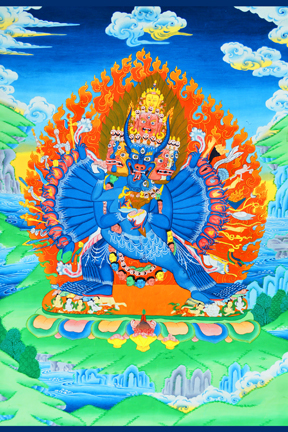
Yamantaka is the wrathful form of Manjushri, the deity of wisdom. The story goes that a yogi was meditating in a cave and along came some thieves with a water buffalo to eat. They cut off the head of the yogi and when the yogi spirit realize he was headless, he took the head of the water buffalo...











































